
I’m wondering if this is the key idea:

(Kindle location 550)
It should be interesting to discover what he means by “naturalistic.”
------------------------------------------------------------------
This following claim is strongly challenged by other thinkers --

(K loc 570)
Chalmers gives us promissory materialism without offering argument or evidence. This is a sign that he is a real star in academic circles. He doesn’t specify in what materialist explanation would consist. I don’t especially fault him for doing this (as it appears to be accepted practice), but I realize that many readers will take his authority as simple proof of his claim. It is not.
Note footnote 1 in this regard. Looks like he has now retreated to intending only brain functions that are physiological and without consideration being given to states of consciousness that may arise from them. I see no objection to that. He concedes in the footnote that his list can be understood to entail a good deal of the hard problem kind of consciousness.
-------------------------------------------------------------------
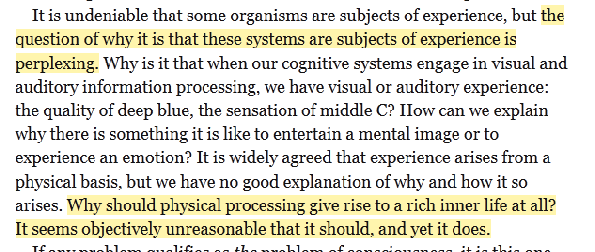
(K loc 585)
MIHI - it is only surprising to those of us, and that’s most of us, who suppose that material entities are all there is. We might say that the fact that it is so puzzling and such an intractable problem indicates the obvious, that it is not part of the material world we envisage. There is clearly and obviously something else. It would be enough, in this regard, to accept a simple dualism of mind and matter. Then you place consciousness in the mind part of things. Also, then, you would take a second look at many paranormal events presently considered anomalies or hoaxes or just not considered at all.
------------------------------------------------------------------------

(K loc 605)
The actual details of this are very complex, and they do in fact exist. See side bar on finding the Jennifer Anniston neuron. It is all about “the ability to discriminate, categorize and react to environmental stimuli.” Specifying the mechanism to perform the function is plainly another case of promissory materialism.
----------------------------------------------------------------------------

(K loc 618)
I like thinking about the instantiation principle, as from Wikipedia:
The "Principle of Instantiation" or "Principle of Exemplification" is a thesis in philosophy that states that there can be no uninstantiated or unexemplified properties (or universals). In other words, it is impossible for a property to exist which is not had by some object. Aristotle is well known for endorsing the principle and Plato for denying it.
Consider a chair. Presumably chairs did not exist 150,000 years ago. Thus, according to the Principle of Instantiation, the property of being a chair did not exist 150,000 years ago either. Similarly (and assuming objects are colored), if all red objects were to suddenly go out of existence, then the property of being red would likewise go out of existence.
Those who endorse the Principle of Instantiation are known as in re realists or "immanent realists".[1]
Seems to me like my belief in the dualism of mind and matter would make me an idealist. Then the universals would exist in mind and mind would have existed for longer than 150,000 years. Of course, for the dualist, material would (I suppose) also have existed for the same time.
------------------------------------------------------------
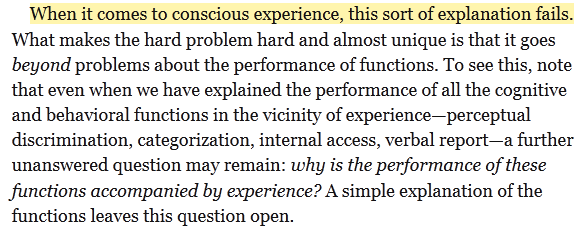
(K loc 630)
The core idea. First we may or may not wish to accept the claim as to the explainability in principle of “all the cognitive and behavioral functions in the vicinity of experience.” In fact I do not in the case of simply living, as is especially clear to the biologist if we consider the growth of the embryo. Chalmers presumes that all the old debates around vitalism have simply been abandoned, and I think this is actually the case for all except the biologists I happen to respect and pay attention to, in particular, Rupert Sheldrake.
However, that objection is not critical to understanding and appreciating Chalmers’ argument. In fact, I find myself agreeing with it, and I see the beauty of its simplicity -- he disposes of all the modern science-based technical materialist positions by simply conceding them. His point is that even if you can build a robot that is essentially indistinguishable from a person with consciousness (with experience), you still haven’t explained consciousness.
I immediately thought of zombies when I saw this idea in Chalmers, and for the first time it made sense to me that, as I already knew, philosophers make much of the concept. Here is what the Stanford Encyclopedia of Philosophy says, from the top:
Zombies in philosophy are imaginary creatures used to illuminate problems about consciousness and its relation to the physical world. Unlike those in films or witchraft, they are exactly like us in all physical respects but without conscious experiences: by definition there is ‘nothing it is like’ to be a zombie. Yet zombies behave just like us, and some even spend a lot of time discussing consciousness.
Few people think zombies actually exist. But many hold they are at least conceivable, and some that they are possible. It is argued that if zombies are so much as a bare possibility, then physicalism is false and some kind of dualism is true. For many philosophers that is the chief importance of the zombie idea. But the idea is also of interest for its presuppositions about the nature of consciousness and how the physical and the phenomenal are related. Use of the zombie idea against physicalism also raises more general questions about relations between imaginability, conceivability, and possibility. Finally, zombies raise epistemological difficulties: they reinstate the ‘other minds’ problem. (Source.)
----------------------------------------------------------------------
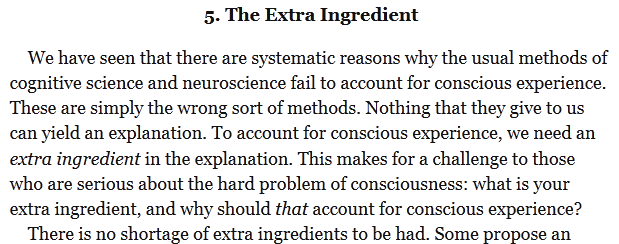
(K loc 750)
I like mind as the extra ingredient. It’s odd that the way Chalmers is taking conscious experience, which he finds it quite impossible for neuroscience to explain, appears to leave the inventive, problem-solving part perfectly explainable by reductive means. One of the easy problems is “the deliberate control of behavior.” He also talks of explaining learning. I say odd because it seems to me that mind the problem-solver and also the purpose-haver are higher-level mental activities than conscious experience itself. That needs more thought. In any case, Chalmers appears not to be discomfited by placing mind the problem-solver in the mechanical or functional part of things considered.
------------------------------------------------

(K loc 780)
See Sheldrake on the inability of DNA et al. to explain the morphogenesis of plants and animals. We understand thousands of microscopic constituents and processes of ordinary cell metabolism, but cannot explain how the cells make the moves necessary for ordinary development of form in the living being. We cannot predict what will develop, given the genome. See The Sheldrake-Wolpert Genome Wager:  . Also consider the unpredictability of crystal shape for new compounds. And the inability to demonstrate than any very complex crystal shape is in fact the most efficient use of the available bonding options, as maintained, on faith, by crystallography.
. Also consider the unpredictability of crystal shape for new compounds. And the inability to demonstrate than any very complex crystal shape is in fact the most efficient use of the available bonding options, as maintained, on faith, by crystallography.
This paragraph fails as to the biology in the view of Sheldrake, and this is the same issue I am considering in this commentary section, but it interestingly adds in the vitalist theory exactly. Sheldrake says he is not a vitalist (since he has his theory of morphogenesis by formative causation and morphogenetic fields, a theory that is quite testable and falsifiable in the ordinary scientific manner of our time. Still, his friend Fritjof Capra says in one interview on Skeptico that Sheldrake is a vitalist, and I can see how that idea arises. Anyway --
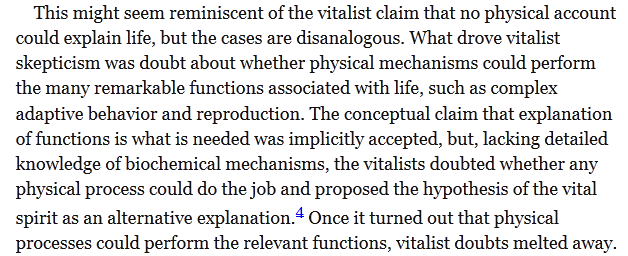
(K loc 800)
It has, of course, not so turned out in Sheldrake’s opinion.
--------------------------------------------------------------------
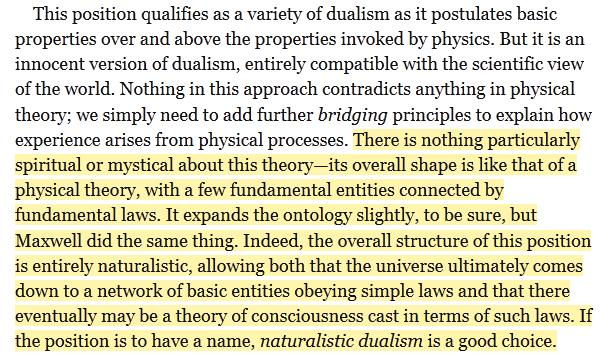
(K loc 840)
This summary confirms some version of Ryle’s category mistake to my mind. The key is that he will have nothing super- or other-naturalistic about this despite the fact that he argues that consciousness cannot, by its very nature, be explained by what we now take to be natural law. Instead natural law must be expanded. Still, “Nothing in this approach contradicts anything in physical theory; we simply need to add further bridging principles to explain how experience arises from physical processes.” This is all very promissory. I’d rather go with Descartes. We’ve got two substances here, whatever a substance might be, one mental, and one physical. There is mind and there is stuff. The two interact. Hmmmm. But that is in a way just what Chalmers is saying — the two interact via bridging principles. Via the pituitary, Descartes said.
---------------------------------------------------------------------
Chalmers’ speculative theory of structural coherence and organizational invariance entails components that appear to be testable only on an assumption of functional reductionism which I think is unproven and very likely mistaken. Of course, see footnote one. He appears to have gotten the same complaint from others and now seeks to limit the degree of functional reductionism he otherwise appears/appeared to be talking about. In any case, I’ll wait to hear from any scientists who actually get around to testing for bridging principles that are outside the realms of both consciousness and ordinary material reality as science understands it.
I have embedded the pdf for the Dennett answer to Chalmers here. Dennett is really, really incisive. He says Chalmers talk of a hard problem that escapes the reductionist science of the brain is just like the Vitalist talk of a hard problem that escapes the reductionist science of biology. Now that science has come a long ways farther, we see that there is not need for an esprit vital and also no need for consciousness in the sense of Descartes and the mind body problem.
My take on Dennett v Chalmers in re vitalism is that they both miss the Sheldrake argument for the reductive inexplicability of morphogenesis. The proper response to the Dennett criticism is for Chalmers to become some kind of vitalist as well as some kind of dualist. Naturalistic dualism and naturalistic vitalism. In fact that is pretty much where Sheldrake is with his new morphogenetic field and the process of formative causation. However, Sheldrake does not seek to place his Maxwellian new stuff in some third realm of bridging principles. He stays reductionist in principle. As I recall, it is when he asks where invention comes from, that he veers off into the metaphysical.
Other thinkers: Ferdinand Schiller, Henri Bergson, and William James are paraphrased and quoted against this productive view of brain (as opposed to transmissive) by Chris Carter in “Does Consciousness Depend on the
Brain?” (2012) pdf.
A modern neuroscientist, Mario Beauregard, argues for the same conclusion via the Schiller and James arguments , then turns to modern proponents of the same position based on empirical data.
, then turns to modern proponents of the same position based on empirical data.
By the beginning of the twentieth century, this materialist view dominated science. Nonetheless, some philosophers and scientists resisted the materialist trend. In 1891, Oxford philosopher Ferdinand Schiller proposed that matter is not what produces consciousness but what limits it. 10 In 1898, William James11— the father of American psychology— pointed out the fact that scientists can only measure correlations: when brain states change in a certain fashion, mental states change too. The fact that mental functions are disturbed when the brain is damaged does not prove that the brain generates mind and consciousness.
Using an elegant analogy we will return to again in this book, James explained what he meant: when white light passes through a prism, he said, the prism allows it to be broken up into all the colors of the spectrum. The prism is not itself the source of the light, but it permits us to see the light differently. In the same way, the brain may permit, transmit, and express mental events and conscious experiences that have their source elsewhere. It does not produce them. James felt that this hypothesis could also account for the effects of drugs and brain damage. 12
To date, a number of scientists and thinkers have used an updated form of James’s analogy to illustrate the mind-brain relationship: equating “mind” with “brain” is as illogical as listening to music on a radio, demolishing the radio’s receiver, and thereby concluding that the radio was creating the music.
(Beauregard, Brain Wars, Kindle Locations 174-186).
John Eccles, an Australian neurophysiologist, was awarded the 1963 Nobel Prize in Physiology or Medicine for his work on the synapse, the tiny junction across which a nerve impulse passes from one neuron to another neuron. Eccles felt that materialist theories fail to account for the wonder of being human: “I maintain that the human mystery is incredibly demeaned by scientific reductionism,” he said. 15 Eccles’s dualistic interactionist theory claims that humans have a nonmaterial mind— belonging to the mental world— that acts upon, and is influenced by, the material brain— which belongs to the physical world. Contrary to Descartes, Eccles argues that the nonmaterial mind is not a substance. Furthermore, he postulates psychic-to-physical laws that regulate the effect of the mind on the brain. 16
(Kindle Locations 201-207)
Like Frederic Myers (a pioneer researcher in the psychology of the unconscious, or “depth psychology,” who greatly influenced William James and the Swiss psychiatrist Carl Gustav Jung), I believe that great progress can be made if we follow a pillar of the scientific method and approach the mind-brain problem empirically: 23 giving priority to the knowledge derived from observations and evidence. 24 (Beauregard, Brain Wars, Kindle Locations 239-243)
Finding the Jennifer Aniston neuron comes to mind as a case in point. This Youtube (done by Dr. John Medina  ) gives a quick presentation of the idea. Here is the actual medical research paper on which his presentation is based -- link.
) gives a quick presentation of the idea. Here is the actual medical research paper on which his presentation is based -- link.
The paper  is fairly accessible and certainly highly interesting. Note that the researchers do not claim that there is only one Jen neuron. Many others may respond quite as strongly when the human in question is presented with her photo. But this one does not respond much at all to photos of other famous people. Of course, this same neuron may be highly active in utterly different conscious experiences, perhaps while drinking tea -- there is no knowing or not knowing about that.
is fairly accessible and certainly highly interesting. Note that the researchers do not claim that there is only one Jen neuron. Many others may respond quite as strongly when the human in question is presented with her photo. But this one does not respond much at all to photos of other famous people. Of course, this same neuron may be highly active in utterly different conscious experiences, perhaps while drinking tea -- there is no knowing or not knowing about that.
Likewise, the experimenters do not claim to know just which neuron is the one they have their probe in (it’s way out of sight) nor how to find it again in the same brain let alone in some other brain.
Significant to the “easy problem” claim by Chalmers is that the experiment in question does not specify a mechanism relating the one-second appearance of a photo of Ms Anniston on a computer to the strong electric response of this or other neurons in the patient’s brain half a second later. Nevertheless, the scientists concerned and many others certainly do consider the experiment a significant milestone along the mechanism road: “The possibility of reading-out information from simultaneously recorded neurons in humans is of considerable value for assessing the feasibility and constrains of brain–machine interfaces, so-called neuroprosthetic devices.” (Same scientists in a later paper analyzing the same data -- link.)
Dr. John Medina is a developmental molecular biologist and research consultant. He is an affiliate Professor of Bioengineering at the University of Washington School of Medicine. He is also the director of the Brain Center for Applied Learning Research at Seattle Pacific University. {From his website.)
Quian Quiroga R, Reddy L, Kreiman G, Koch C, Fried I. Invariant visual representation by single neurons in the human brain. Nature 435: 1102–1107, 2005.
Searching on Kindle, I see he gets around to using the word a hundred times later in his book.
On July 9 2009, in the New Scientist, Lewis Wolpert and Rupert announced a wager on the predictive power of the genome.
The wager will be decided on May 1, 2029, and if the outcome is not obvious, the Royal Society, the world’s most venerable scientific organization, will be asked to adjudicate. The winner will receive a case of fine port, Quinta do Vesuvio, 2005, which should have reached perfect maturity by 2029 and is being stored in the cellars of The Wine Society.
Lewis Wolpert bets that the following will happen. Rupert bets it will not:
By May 1, 2029, given the genome of a fertilized egg of an animal or plant, we will be able to predict in at least one case all the details of the organism that develops from it, including any abnormalities.
Both agree that at present, given the genome of an egg, no one can predict the way an embryo will develop.
The wager arose from their debate on the nature of life at the 2009 Cambridge University Science Festival, which you can hear in streaming audio [here.]
Both have set out their cases in New Scientist here: The Genome Wager
The huge response to Chalmers’ original paper shows how deeply his idea cores. See his response to the response. (Also in the present text, but abridged.) I read Dennett’s first (here)  and see that his counter argument is to make his own version of my vitalist objection to the explainability in principle of the material functions of consciousness and use that as mockery of the absurdity of Chalmers’ position. Neither philosopher wants to look into the truly paradigm shifting ideas of Sheldrake.
and see that his counter argument is to make his own version of my vitalist objection to the explainability in principle of the material functions of consciousness and use that as mockery of the absurdity of Chalmers’ position. Neither philosopher wants to look into the truly paradigm shifting ideas of Sheldrake.
Dennett’s significance in the world of consciousness studies is doubtless revealed in the title Chalmers gave to his response to the responses – “Moving Forward on the Problem of Consciousness.” Dennet’s response having been:
“Facing Backwards on the Problem of Consciousness.” The original Chalmers paper was called, “Facing up to the Problem of Consciousness.”
At the end of his brief reposte, Dennett challenges Chalmers with the fact that he has no experimental data that require explanation by his new bridging principles, but only a reiterated claim that there is something special about consciousness. This is an excellent criticism. Notice that Sheldrake does provide many such data in his studies of the paranormal. In effect, that is what Chalmers should do and by now, given how popular he is in Tuscon, he may have done it.
| Retirement Reading |
| Mind-Matter |
| Other Minds' Matter |
| Occasional Notes |
| My Cognitive Dissonances |
| Preface on Definition |
| Mind-Matter Argument 1 |
| Mind-Matter Argument 2 |
| Mind-Matter Argument 3 |
| Mind and Matter Quick View |
| endnote 1 to M-M Arg 1 |
| endnote on illusions |
| endnote 2 to M-M Arg 1 |
| How the Real World Thinks |
| Huxley's Argument |
| Friend's Argument |
| Zerah Colburn |
| Mind-Matter Argument 2-1 |
| Mind-Matter Argument 2-2 |
| Mind-Matter Argument 2-3 |
| endnote 5 to M-M Arg 2 |
| Three Body Problem |
| endnote 1 to M-M Arg 2 |
| endnote 2 to M-M Arg 2 |
| endnote 3 to M-M Arg 2 |
| endnote 4 to M-M Arg 2 |
| Sophistry in America |
| Chris Carter |
| David Chalmers |
| Bernard Haisch |
| My Mind-Matter Bibliography |
| Reading Notes on Chalmers |
| Sheldrake Summary |
| A suicide, a poem, a song, some thought |
| My Little UFO |
| Medicine Health Notes |
| Plato and associates |
| Quantum Mechanics |
| EPR-Bell-Aspect |
| Vaccination |
| Maintaining the People's Faith |
| Government |
| Does HIV cause AIDS ? |
| 9-11 |
| Whistleblower issues |
| Same Study Different Takes |
| The Body of Evidence |
| Overview |
| Public Hygiene |
| Polio Vaccine Contamination Issues |
| Tetanus Supporting Items |
| What Happened to Karen Sykes? |
| CSM story of June 21, 2014 |
| Mind-Matter |
| Other Minds' Matter |
| Occasional Notes |
| My Cognitive Dissonances |
| Preface on Definition |
| Mind-Matter Argument 1 |
| Mind-Matter Argument 2 |
| Mind-Matter Argument 3 |
| Mind and Matter Quick View |
| endnote 1 to M-M Arg 1 |
| endnote on illusions |
| endnote 2 to M-M Arg 1 |
| How the Real World Thinks |
| Huxley's Argument |
| Friend's Argument |
| Zerah Colburn |
| Mind-Matter Argument 2-1 |
| Mind-Matter Argument 2-2 |
| Mind-Matter Argument 2-3 |
| endnote 5 to M-M Arg 2 |
| Three Body Problem |
| endnote 1 to M-M Arg 2 |
| endnote 2 to M-M Arg 2 |
| endnote 3 to M-M Arg 2 |
| endnote 4 to M-M Arg 2 |
| Sophistry in America |
| Chris Carter |
| David Chalmers |
| Bernard Haisch |
| My Mind-Matter Bibliography |
| Reading Notes on Chalmers |
| Sheldrake Summary |
| A suicide, a poem, a song, some thought |
| My Little UFO |
| Medicine Health Notes |
| Plato and associates |
| Quantum Mechanics |
| EPR-Bell-Aspect |
| Vaccination |
| Maintaining the People's Faith |
| Government |
| Does HIV cause AIDS ? |
| 9-11 |
| Whistleblower issues |
| Same Study Different Takes |
| The Body of Evidence |
| Overview |
| Public Hygiene |
| Polio Vaccine Contamination Issues |
| Tetanus Supporting Items |
| What Happened to Karen Sykes? |
| CSM story of June 21, 2014 |
| Chris Carter |
| David Chalmers |
| Bernard Haisch |
| My Mind-Matter Bibliography |
| Reading Notes on Chalmers |
| Sheldrake Summary |
| Reading Notes on Chalmers |
| Sheldrake Summary |


